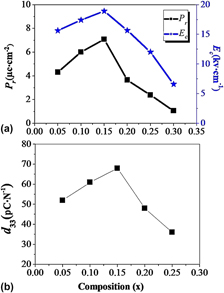Crossref Citations
This article has been cited by the following publications. This list is generated based on data provided by
Crossref.
Parida, B. N.
Das, Piyush R.
Padhee, R.
and
Choudhary, R. N.P.
2013.
Phase transition in tungsten–bronze Li2Pb2Nd2W2Ti4Nb4O30ferroelectric.
Phase Transitions,
Vol. 86,
Issue. 8,
p.
778.
Wei, Lingling
Han, Xiaokun
Chao, Xiaolian
Jiao, Huan
and
Yang, Zupei
2014.
Study on low temperature sintering and electrical properties of CuO-doped Ca0.28Ba0.72Nb2O6 ceramics.
Journal of Materials Science: Materials in Electronics,
Vol. 25,
Issue. 4,
p.
1605.
Das, Piyush R.
Sutar, B. C.
Pati, B.
and
Choudhury, R. N. P.
2014.
Structural and Electrical Properties of Complex Tungsten Bronze Ferroelectrics ; Li2Pb2La2W2Ti4V4O30.
Ferroelectrics,
Vol. 467,
Issue. 1,
p.
50.
Wei, Lingling
Yang, Zupei
Chao, Xiaolian
and
Jiao, Huan
2014.
Structure and electrical properties of Ca0.28Ba0.72Nb2O6 ceramics with addition of rare earth oxides (CeO2, La2O3).
Ceramics International,
Vol. 40,
Issue. 4,
p.
5447.
Wei, Lingling
Chao, Xiaolian
Han, Xiaokun
and
Yang, Zupei
2014.
Structure and electrical properties of textured Sr1.85Ca0.15NaNb5O15 ceramics prepared by the reactive templated grain growth.
Materials Research Bulletin,
Vol. 52,
Issue. ,
p.
65.
Yang, Pei
Li, Lei
Hao, Shenglan
Chao, Xiaolian
Wei, Lingling
and
Yang, Zupei
2017.
Electrical and transparent properties induced by structural modulation in (Sr0.925Ca0.075)2.5–0.5Na Nb5O15 ceramics.
Journal of the European Ceramic Society,
Vol. 37,
Issue. 7,
p.
2605.
Li, Lei
Hao, Shenglan
Chao, Xiaolian
Wei, Lingling
and
Yang, Zupei
2017.
Structure and Electrical Properties of Sr1.85Ca0.15NaNb5O15 Ceramics with Addition of Multivalence Oxides (MnO2, PbO2).
Journal of Electronic Materials,
Vol. 46,
Issue. 10,
p.
5967.
Hao, Shenglan
Li, Jinhong
Yang, Pei
Wei, Lingling
and
Yang, Zupei
2017.
Enhanced electrical properties and strong red light‐emitting in Eu3+‐doped Sr1.90Ca0.15Na0.9Nb5O15 ceramics.
Journal of the American Ceramic Society,
Vol. 100,
Issue. 12,
p.
5620.
Li, Lei
Yang, Bian
Chao, Xiaolian
Wu, Di
Wei, Lingling
and
Yang, Zupei
2019.
Effects of preparation method on the microstructure and electrical properties of tungsten bronze structure Sr2NaNb5O15 ceramics.
Ceramics International,
Vol. 45,
Issue. 1,
p.
558.
Cao, Lei
Yuan, Ying
Li, En Zhu
and
Zhang, Shu Ren
2020.
Improvement of Dielectric Breakdown Strength in (1-x)Sr<sub>0.7</sub>Ba<sub>0.3</sub>Nb<sub>2</sub>O<sub>6</sub>-xSr<sub>0.7</sub>Bi<sub>0.2</sub>TiO<sub>3</sub> Ceramics.
Key Engineering Materials,
Vol. 842,
Issue. ,
p.
153.
Cao, Lei
Yuan, Ying
Zhang, Xing
Li, Enzhu
and
Zhang, Shuren
2020.
Relaxor Nature and Energy Storage Properties of Sr2–xMxNaNb5–xTixO15 (M = La3+ and Ho3+) Tungsten Bronze Ceramics.
ACS Sustainable Chemistry & Engineering,
Vol. 8,
Issue. 47,
p.
17527.
Yang, Bian
Li, Jinhong
Yang, Pei
Wei, Lingling
and
Yang, Zupei
2020.
Effects of A-site cations on the electrical behaviors in (Sr1-Ca )2.1Na0.8Nb5O15 tungsten bronze ferroelectrics.
Materials Chemistry and Physics,
Vol. 243,
Issue. ,
p.
122006.
Cao, Lei
Yuan, Ying
Tang, Bin
Li, Enzhu
and
Zhang, Shuren
2020.
Excellent thermal stability, high efficiency and high power density of (Sr0.7Ba0.3)5LaNb7Ti3O30–based tungsten bronze ceramics.
Journal of the European Ceramic Society,
Vol. 40,
Issue. 6,
p.
2366.
Wang, Ying
Sun, Tu Lai
Zhu, Xiao Li
Liu, Lu
and
Chen, Xiang Ming
2021.
Ferroelectric transition and structural modulation in Sr2Na(Nb1−xTax)5O15 tungsten bronze ceramics.
Journal of Applied Physics,
Vol. 129,
Issue. 24,
Xu, Shudong
Peng, Zhanhui
Shi, Hao
Chao, Xiaolian
Wu, Di
Liang, Pengfei
Wei, Lingling
and
Yang, Zupei
2021.
Electrical conduction behavior in nonstoichiometric BaBi Nb5O15±δ tungsten bronze ceramics.
Ceramics International,
Vol. 47,
Issue. 16,
p.
22382.
Brown, Thomas
Brown, Andy P.
Hall, David A.
Hooper, Thomas E.
Li, Yizhe
Micklethwaite, Stuart
Aslam, Zabeada
and
Milne, Steven J.
2021.
New high temperature dielectrics: Bi-free tungsten bronze ceramics with stable permittivity over a very wide temperature range.
Journal of the European Ceramic Society,
Vol. 41,
Issue. 6,
p.
3416.
Zhang, Xinzhong
Ye, Wenbo
Bu, Xingying
Zheng, Peng
Li, Lili
Wen, Fei
Bai, Wangfeng
Zheng, Liang
and
Zhang, Yang
2021.
Remarkable capacitive performance in novel tungsten bronze ceramics.
Dalton Transactions,
Vol. 50,
Issue. 1,
p.
124.
Luo, Chong
Zheng, Xiangting
Zheng, Peng
Niu, Ziang
Zhang, Kai
Bai, Wangfeng
Fan, Qiaolan
Zheng, Liang
and
Zhang, Yang
2022.
Realizing Excellent Energy Storage Performances in Tetragonal Tungsten Bronze Ceramics Via a B-Site Engineering Strategy.
SSRN Electronic Journal,
Luo, Chong
Zheng, Xiangting
Zheng, Peng
Du, Juan
Niu, Ziang
Zhang, Kai
Bai, Wangfeng
Fan, Qiaolan
Zheng, Liang
and
Zhang, Yang
2023.
Realizing excellent energy storage performances in tetragonal tungsten bronze ceramics via a B-site engineering strategy.
Journal of Alloys and Compounds,
Vol. 933,
Issue. ,
p.
167809.
Feng, Wenbin
Xu, Yafei
Li, Xianguang
Wu, Yanyan
and
Yang, Jingjing
2023.
Enhanced energy storage properties in Sr1.85Ca0.15NaNb5O15-based tungsten bronze ceramics through multicomponent substitution.
Journal of Materials Science: Materials in Electronics,
Vol. 34,
Issue. 2,





